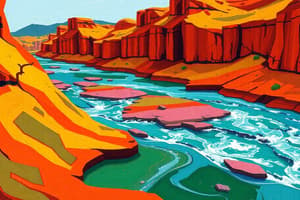Podcast
Questions and Answers
What is the primary mechanism by which rivers shape their surrounding landscapes?
What is the primary mechanism by which rivers shape their surrounding landscapes?
- Weathering and glaciation
- Erosion, transportation, and deposition of rock and sediment (correct)
- Tectonic plate movement and volcanic activity
- Human engineering and construction
Which process leads to the formation of meanders and oxbow lakes?
Which process leads to the formation of meanders and oxbow lakes?
- Downcutting
- Deposition
- Lateral erosion (correct)
- Erosion
What type of river landform is characterized by the accumulation of sediment at the mouth of a river?
What type of river landform is characterized by the accumulation of sediment at the mouth of a river?
- Floodplain
- Canyon
- Delta (correct)
- Meander
What is the term for the steep drops in a river's course, formed by erosion and differential weathering?
What is the term for the steep drops in a river's course, formed by erosion and differential weathering?
Which of the following is NOT a type of river landform?
Which of the following is NOT a type of river landform?
What is the term for the movement of sediment downstream by the river's flow?
What is the term for the movement of sediment downstream by the river's flow?
Flashcards are hidden until you start studying
Study Notes
River Landforms
Formation of River Landforms
- Rivers carve out landscapes through erosion, transportation, and deposition of rock and sediment
- River landforms are shaped by the river's flow, velocity, and sediment load
Types of River Landforms
- Deltas: Depositional landforms at the mouth of a river, where sediment accumulates
- Floodplains: Flat or low-lying areas surrounding a river, formed by periodic flooding and deposition of sediment
- Meanders: Curved or bent channels in a river, formed by erosion and deposition on the inner and outer banks
- Oxbow Lakes: Abandoned meanders, formed when a meander is cut off from the main river channel
- Waterfalls: Steep drops in a river's course, formed by erosion and differential weathering
- Canyons: Deep, narrow valleys carved out by a river, often with steep sides
- Levees: Natural or artificial ridges along a river, formed by deposition of sediment during flooding
Processes Shaping River Landforms
- Erosion: Removal of rock and sediment by the river's flow
- Transportation: Movement of sediment downstream by the river's flow
- Deposition: Accumulation of sediment in a new location, such as at a river mouth or on a floodplain
- Lateral erosion: Erosion of the riverbanks, leading to the formation of meanders and oxbow lakes
- Downcutting: Erosion of the riverbed, leading to the formation of canyons and waterfalls
River Landforms
Formation of River Landforms
- Rivers shape landscapes through erosion, transportation, and deposition of rock and sediment
- Flow, velocity, and sediment load determine the formation of river landforms
Types of River Landforms
- Deltas: Formed by sediment accumulation at a river's mouth
- Floodplains: Created by periodic flooding and sediment deposition, resulting in flat or low-lying areas
- Meanders: Curved channels formed by erosion on the outer banks and deposition on the inner banks
- Oxbow Lakes: Abandoned meanders formed when a meander is cut off from the main river channel
- Waterfalls: Steep drops in a river's course formed by erosion and differential weathering
- Canyons: Deep, narrow valleys carved out by a river, often with steep sides
- Levees: Natural or artificial ridges formed by sediment deposition during flooding
Processes Shaping River Landforms
- Erosion: Removal of rock and sediment by the river's flow
- Transportation: Downstream movement of sediment by the river's flow
- Deposition: Accumulation of sediment in a new location, such as at a river mouth or on a floodplain
- Lateral erosion: Riverbank erosion leading to meander and oxbow lake formation
- Downcutting: Erosion of the riverbed, resulting in canyon and waterfall formation
Studying That Suits You
Use AI to generate personalized quizzes and flashcards to suit your learning preferences.



